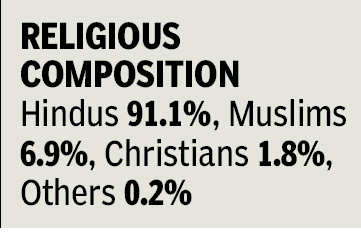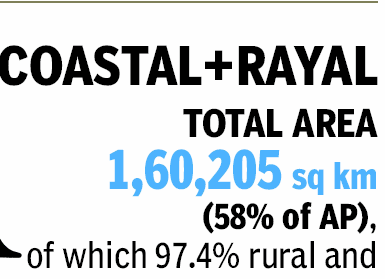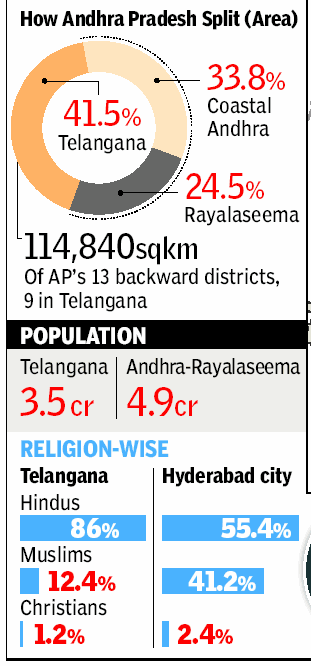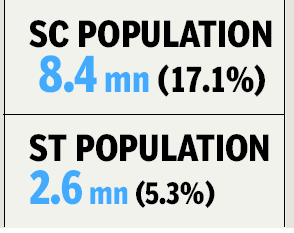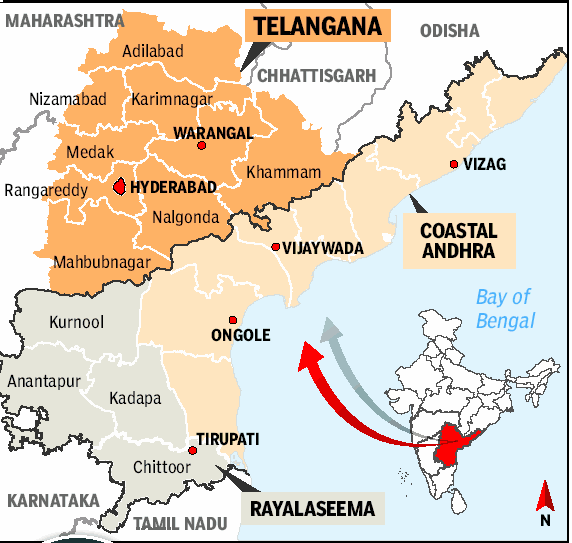Andhra Pradesh (1953-2014)
This is a collection of articles archived for the excellence of their content. Readers will be able to edit existing articles and post new articles directly |
The Times of India 2013/07/31 [1]
[2]
[3]
Andhra Pradesh (1953-2013)
Telangana and Andhra: 1953-2013
A chronology
1953: FORCED MARRIAGE between Telangana and Andhra
States Reorganization Committee (1953) advised against immediate merger with Andhra
Said region’s opinion yet to crystallize and back a merger Telangana’s economy less developed than Andhra But revenue base larger as it taxed liquor.
In Andhra liquor was prohibited Fears of liquor revenues diverted to Andhra
Worried that irrigation projects in Krishna & Godavari wouldn’t benefit them
Feared the better-educated Andhraites would dominate Andhra would have unfair advantage over jobs
WHAT WAS PROPOSED (in 1953)
Telangana be separate state
Merge only if unification resolution passed in Telangana House with 2/3 majority after 1961 general elections
Hyderabad state CM Burgula Ramakrishna Rao said majority in Telangana against merger But he backed Cong decision to merge region with Andhra
THE 1950s: PRE-NUP CONTRACT
Nov 25, 1955, Andhra assembly passed resolution to provide safeguards to Telangana
Vowed to treat region as a “special charge” Promised guarantees for region’s development These included quotas in jobs, educational institutions
Agreement on Feb 20, 1956 on merger with promised safeguards
Telangana merged with Andhra state to form Andhra Pradesh on November 1, 1956
Deal provided reassurances to Telangana in terms of powersharing and administrative domicile rules and distribution of expenses of various regions
MOVE TO SEPARATE Telangana
Massive revolt of Telangana people in 1968-69 demanding separation called Jai Telangana Movement
As conciliatory measure, All-Party Accord signed in Jan 1969 under Brahmananda Reddy Indira Gandhi announced packages for region, styled eight-point formula and fivepoint formula
When these packages were being worked out, SC gave historic Mulki Rules judgment This upheld the rule of job and educational quotas in Telangana for region’s residents But political elite of Andhra region didn’t digest these corrective measures This gave rise to separate Andhra state stir — Jai Andhra Movement
Jai Andhra leaders demanded scrapping guarantees to Telangana people or bifurcation Venkaiah Naidu and Chandrababu Naidu, among others, were in forefront of Jai Andhra stir Centre yielded and nullified, by act of Parliament, almost all safeguards.
The SC judgment on Mulki rules disregarded a diluted 6-point formula foisted on people
THE SPLIT
December 2009, home minister Chidambaram says Centre serious about Telangana
July 30, 2013: creation of Telangana announced
A history of the union between Andhra and Telangana
Andhra: A break-up after a 58-yr chequered existence
Manoj Mitta | TNN
The Times of India 2013/07/31
India’s first linguistic state
It was billed as India’s first linguistic state, formed in 1956 through a merger of the Andhra state with the Telangana region of the Hyderabad state. Though its template of a linguistic state was replicated in other parts of the country, Andhra Pradesh is breaking up after a chequered 58-year existence.
The pioneering experiment in making language the basis of state formation was doomed from its inception. For, AP was a forced union, as evident from the forebodings in the contemporaneous report of the States Reorganization Commission (SRC). The Andhra and Rayalaseema regions were forced on Telangana, primarily for the coveted prize of Hyderabad city and for the wealthy coastal area to gain control over the upper riparian area.
The new map of the landmass that was till 2013-14 called AP will be closer to the one around the time of independence. It was then an overlap of Madras presidency and the princely state of Hyderabad. Following the “police action” in Sept 1948, Hyderabad ruled by the Nizams became the last major state to join the Indian union.
1948-1952: Hyderabad
In its three-year transition to democracy, the composite Hyderabad state, which comprised Telangana, Marathwada and northeastern Karnataka districts, was governed first by a military administrator (Maj Gen J N Chaudhuri), then a chief executive (ICS officer M K Vellodi). Hyderabad acquired its first elected government in 1952, when Cogress leader Burgula Ramakrishna Rao was sworn in as CM.
Andhra carved out of Madras
The existence of the nascent Hyderabad state came under a shadow a year later when the Andhra state was carved out of Madras, following the death of Telugu champion Potti Sreeramulu in the course of his fast. This was the first break-up of a state on the question of language. The Hyderabad state was feeling the heat of the Vishalandhra movement in the new Andhra state, demanding a unification of all Telugu-speaking districts. The movement was fuelled partly by the absence of a readymade capital in the Andhra state, which was being administered literally out of tents from the small town of Kurnool.
1953: SRC (States Reorganization Committee )
Though it was appointed in 1953 to pave the way for Vishalandhra, SRC headed by ex-SC judge Fazal Ali threw a spanner in the works when it gave its report two years later. It cautioned against any forced union saying “while public opinion in Andhra is in favour of the large unit, public opinion in Telangana has still to crystallize itself.” Disregarding SRC’s warning, the Nehru government yielded to pressure from Andhra. The SRC has proved to be prescient.
Telangana agitation: YSR stoked T-fire to trip Naidu
Subodh Ghildiyal TNN The Times of India
The contemporary Telangana agitation, the last and the most successful over six decades, started as a cynical move on the part of the most virulent opponent of division of Andhra Pradesh, Y S Rajasekhara Reddy [YSR].
YSR had stoked the Telangana sentiment and associated himself with regional aspirations just to trip the unshakeable Chandrababu Naidu. But once in power, he contested in 2009 against statehood and managed to decimate TRS in its stronghold to prove that there was no sentiment for statehood. He emerged the undisputed czar of AP. Telangana appeared doomed for another heartbreak, but for the air crash that killed YSR early in his second innings as CM.
YSR aides recall how the Cogress strongman became desperate as his friend Naidu dug in his heels as CM. Concern was rife that another victory in 2004 would push Cogress and YSR to irrelevance. Thinking on his feet, he devised a four-point strategy to make Naidu suspect among regions and social groups, Telangana, peace with Maoists, free power and padayatra.
“We threw everything at Naidu that we could. It was a desperate move,” a key follower and Cogress minister from Andhra recalled.
The break-up of Andhra Pradesh
POWER SHIFT
What the break-up of Andhra Pradesh means for the Telugu people=
Divided AP to lose political clout
TIMES NEWS NETWORK
The partition of Andhra will cause the state to lose the political clout it wielded since ’90s in national politics.
With 42 seats in Lok Sabha, Andhra along with West Bengal accounts for the third biggest kitty of LS seats after UP (80) and Maharashtra (48). It climbed to the third spot after the partition of Bihar saw its share of LS seats dipping from 54 to 40, with the rest going to Jharkhand.
After AP’s bifurcation, 17 LS seats will be allotted to Telangana, leaving the mother state with 25 seats, the same as Rajasthan. The heft that the number of seats equipped it with had enabled the state to be the playmaker in successive polls, especially since 1996. N Chandrababu Naidu-led TDP emerged as the anchor of the two UF governments. TDP’s switch to the Vajpayee camp was a key factor in BJP’s success in holding on to power in the mid-term LS polls in 1999.
The state, along with TN and Bihar, played a big role in Cogress’s surprise win in 2004, with the late YSR leading the party to a landslide in LS and state polls that year. YSR defied incumbency and the popular wisdom to pull off an encore five years later, helping Cogress to outgun the BJP decisively in the 2009 polls. Both in 2004 and in 2009, the state yielded the largest chunk of MPs for not only Cogress but for any party from a state. The party won 29 of the 42 seats in 2004 and 33 in 2009.
What the break-up of Andhra Pradesh means for Telangana
Control over Krishna and Godavari waters Catchment of 68% Krishna | 69% Godavari river
But so far, Telangana got only 32% Krishna water. Agitators said should get 70%
Prakasam Barrage, Nagarjuna Sagar, Srisailam draw away water to other AP regions
Benefits of irrigation canals | 74% Coastal Andhra | 18% Telangana | 8% Rayalaseema 45% of AP’s forest area in Telangana across five districts
Singareni collieries excavate coal for industry, power stations
Power generated supplied to entire south India
Region has limestone deposits, besides bauxite & mica
Jobs For [Telangana] Region's People
Only 20% AP’s Govt employees were from Telangana, Population-wise, should have been 40% , more than 6 lakh. In reality, barely 3 lakh
Less than 5% dept heads in AP govt were from Telangana
Only 6 out of 12 AP CMs from Telangana
As A State
Telangana’s per capita income, 10th highest in country, notch above all-India average
In absolute GDP terms, Telangana (without Hyd) above Chhattisgarh, Jharkhand, U’khand, HP, Goa. Among all states, at 15th place
TELANGANA statistics
68% Krishna waters
45% of andhra’s forest area 20% of country's coal deposits 50% ap revenues are from here [Telangana]
What the break-up of Andhra Pradesh means for Andhra
In absolute GDP size, Andhra region third among states
Per capita income of Andhra 11th highest, above all-India average
Rich in agriculture, owing to Godavari and Krishna deltas
Within AP, coastal Andhra is superior economic entity
Considered a rice bowl
Now loses control over rivers Krishna and Godavari
Loses control over mineralrich Telangana region
Has to develop a new capital city
Loses Telangana revenue that was 50% of state revenues
What the break-up of Andhra Pradesh means for Rayalaseema
Srikrishna Panel called it AP’s most deprived/ backward region
This, despite fact that five AP CMs from Rayalaseema, among them YSR, Chandrababu Naidu
Compared to Telangana and Andhra, Rayalaseema worse off in industry. Basically agrarian
Flight of capital from Rayalaseema to Karnataka with Reddy community investing in real estate and industry in Karnataka
Perception that Andhra region exploitative
With Telangana carved out, possibility of Greater Rayalaseema statehood demand
What the break-up of Andhra Pradesh means for the ‘rump state’
‘Rump state to be eco powerhouse’
The new rump state that will remain after Telangana is carved out will emerge as an economic powerhouse with the growth of coastal AP and cities like Visakhapatnam and Vijayawada, many feel. In the past four to five years coastal Andhra industrialists have pumped money into the region, in pharma, chemicals and petrochemicals.
’Rayala Telangana’: Caste and power
The contested ideas of Rayala Telangana
Kingshuk Nag 30 July 2013
UnitedAndhra Pradesh was dominated by the Reddys, followed by Kapus and SCs
The Cogress in Andhra Pradesh has been the domain of the Reddys ever since it struck deep roots in this part of the world with the Kapus (an intermediate farming caste) and the Dalits as junior partners. Reddys form only 8% of the state's population but as feudal lords in a state where land reforms have been conspicuous by their absence, their influence extends far beyond their numbers.
For example, 10 out of the 16 chief ministers of Andhra Pradesh have been Reddys, with some serving multiple terms. With the creation of Telangana, the hegemony of the Reddys is expected to be broken with new caste equations coming into play. In Rayala Telangana, where Telangana would have been fused with two districts of Rayalaseema, would have maintained Reddy dominance in one of the successor states of the present Andhra Pradesh.
In the new Andhra state (called Andhra Pradesh!), the Kapus and Kammas (represented by Chandrababu Naidu's TDP) will vie for power, leaving the Reddys nowhere.
No wonder then that Jaipal Reddy, a Union minister and staunch Reddy, is credited with the Rayala Telangana plan along with senior national Muslim ministers, who are apprehensive that in the new Telangana state, the spectre of Hindu-Muslim conflict reminiscent of the last decade of the Nizam's rule will hang thick. Stories suggest that these national Muslim ministers had been lobbied by parties like MIM (representing Muslim interests), that the forces will be more "even" if the two Rayalaseema districts are tagged on to Telangana. Some Rayalaseema districts have large Muslim populations, being part of the Nizam's territories that were later ceded to the British. The BJP, conspicuous by its absence in Andhra Pradesh, is looking at the new Telangana as a launching pad in this part of the world.
Rayalaseema
Besides this caste rationale, the attempt to create Rayala Telangana was to stymie future demand for a Rayalaseema state. Even as the Telangana movement was raging, influential political figures raised the demand for a separate Rayalaseema state. Not surprising, considering the wide perception among people of Rayalaseema that they would be dominated by Andhra region folks in a new dispensation.
The demand included the creation of a new state, including Bellary district of neighbouring Karnataka that is historically part of Rayalaseema. Breaking up Rayalaseema, with two districts going to Andhra and two to Telangana, would ensure that the demand for a separate state will be nipped in the bud.
People of Rayalaseema were distressed at the prospects of Rayala Telangana. The common man in Rayalaseema sees this as a blow to his identity. A senior IPS officer submitted his resignation from the service to protest against the move.
Although Rayalaseema has been the home of many Andhra chief ministers starting with Neelam Sanjeeva Reddy, who was later President of India, the region is marked by extreme backwardness. Once part of the Vijayanagara empire, the area fell on bad times later.
For hundreds of years till the 2000s, it was the state's wild west with a culture of violence, bombs and assassinations. There was no economic activity and unirrigated land was the asset over which families and factions fought and killed for generations.
This is why the people of Telangana are so cut up with the idea of being boxed in a new state with parts of Rayalaseema. "We don't even intermarry with them. Fusing Rayalaseema into Telangana will give them a free run here, where we don't want them," a journalist from Telangana told writer Kingshuk Nag. That is why the Telangana Rashtra Samiti which was in the vanguard of the movement has rejected the Rayala Telangana idea, as has the BJP.
